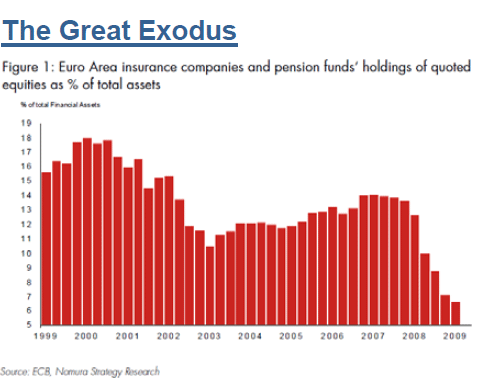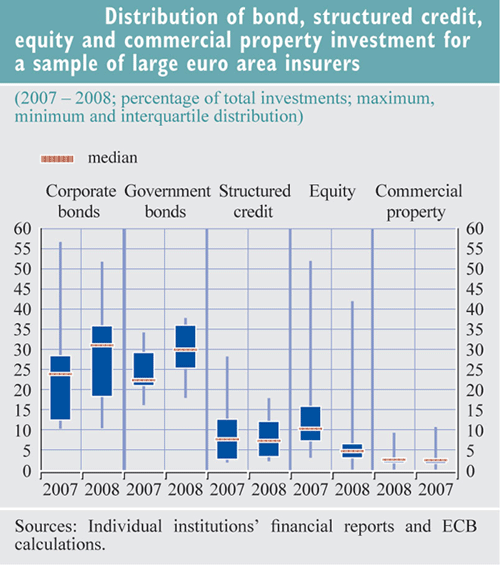What will be the impact on IR of a move from Active to Passive?
Some say the move from Active to Passive investment strategies is inevitable because the cost/performance differential can’t be justified.
A recent survey by the IBM Institute for Business Value covering 2,750 investment industry executives, including those at endowments, foundations, and SWFs, predicts that passive investments will overtake actively managed funds. Today 70% of global assets are in active funds, which charge 1.25% on average. But over the next three years, 65% of respondents planned to move to passive strategies which charge less than 0.2%. Extrapolating the data suggests that in 20 years, 85-90% of assets will be in passive strategies, with the remaining 10-15% in hedge funds, private equity and other alternative asset classes.
But just as the recent financial crisis has exposed the flaws in efficient-market hypothesis (EMH), so a move to more indexing could provide opportunities for active managers.
Talk of London-based hedge fund exodus to Switzerland is exaggerated
In our daily interactions with the Swiss investment community we see very little evidence of the arrival of London-based fund managers fleeing the UK to Switzerland so we don’t believe there will be much impact on the targeting efforts of IROs for the time being.
As Bill McIntosh of the Hedge Fund Journal points out in a recent article, as much as 90% of the European industry’s $300 billion plus in assets is managed, directly or indirectly, from London and it is likely to stay that way. He explains that “There is a lot of talk, not too much action,” but points out that “anecdotal evidence suggests that many small-to-medium sized firms are also looking to enhance their operational flexibility. One thing that is occurring, according to a leading prime broker, is that firms are exploring setting up a management company in a more tax efficient locale. This is seeing some funds set up a second leg in Switzerland but still keep London as the main operating centre. Though London is expected to be the top European financial services hub for the foreseeable future, hedge fund principals can decamp to build a second leg but still visit the UK weekly or fortnightly, thus escaping the clutches of the Inland Revenue.”
He goes on to point out that “Another spur for setting up a Swiss office is to take advantage of the light regulatory structure. At a time when regulatory upheaval is a certainty in both Europe and the US, the Swiss system’s use of referenda means that change, if it comes, will be slow. But it could be tricky to decamp completely from the UK in case the AIM directive puts heavy restrictions on non-EU funds. So it seems likely that firms will want to guard their EU regulatory optionality by keeping a London presence. Having dual offices thus gives a fund a regulatory toe-hold in each system.”
“Consultants and managers note that life style, too, is a key consideration. Firms that canvas their partners about moving abroad often find it difficult to convince wives and family to rip up their lifestyles and relationships. The Swiss Alps may be beautiful and have their fans, especially among partners with young families, but the cantons around Zurich can be tough socially for non-German speakers. And Zurich, whatever its charms, pales beside London as a cultural and entertainment centre.”
“Nor should it be forgotten that Switzerland is itself badly bruised from the credit crunch. Private bank customers in Geneva lost an estimated $7 billion in Madoff and many funds-of-funds in the city are still bleeding. The woes that have afflicted UBS have ensured that Zurich, too, has felt the pain. Moreover, capital is flowing out as tax amnesties in Italy and Germany encourage investors to bring money home.“
Talk of London-based hedge fund exodus to Switzerland is exaggerated. Indeed, the fall of sterling against the euro and the Swiss franc even gives the UK a competitive cost advantage.
SWF invest $1 trillion in global equity markets – less than expected
Sovereign wealth funds invest about $1 trillion in international equities which is less than half the $2.2 trillion (end 2008) managed by the 10 largest SWFs, according to a report by RiskMetrics commissioned by the Investor Responsibility Research Center Institute (IRRC).
The report said: “The current total size of the SWFs and the percentage invested in international equities is less than the figures generally reported in the media. Consequently estimates of their potential impact on the international capital markets are exaggerated.”
The study found that the total capital available to SWFs has decreased as the global financial crisis has dampened demand for some of the exports these countries rely on to bolster their funds. As a result, their global equity exposures have decreased, while their bond allocations have increased.
Why Active Share is important for IROs
In 2006 two Yale academics (Cremers, M. and Petajisto) introduced the term Active Share as a measure of active portfolio management. The term measures the degree of overlap in holdings at the stock level between the fund manager and their benchmark index. An Active Share of 100% implies zero overlap with the benchmark while a pure index fund will have an Active Share of 0%.
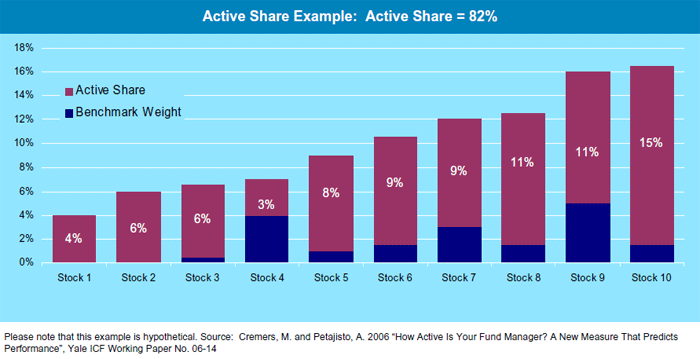
Unfortunately, as shown in the chart below, Active Share has been declining over time which means that many funds are increasingly mirroring their index. This is due to the increased use of passive investment techniques but also because of the widespread use of benchmarks by active managers. The rise of these “Closet Indexers” is an issue for IROs when considering which investors to target. This is especially important as many so-called “Active” fund managers may actually be “Closet Indexers” who will typically only overweight or underweight their positions very slightly.
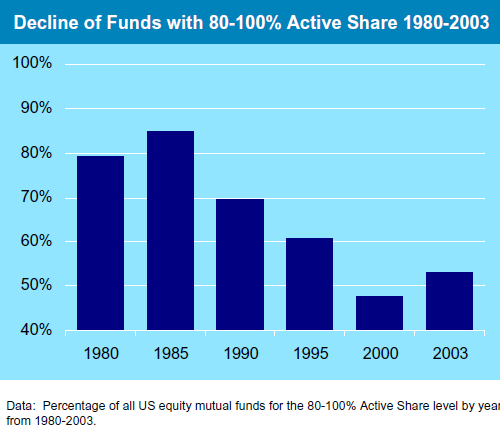
Spending valuable management time with a “Closet Indexer” will have little impact on marginal additional purchases of stock. Therefore, it is clearly very important for IROs to be able to identify the stock pickers with concentrated portfolios in order to achieve the most from their meetings.
The great exodus from equities?
Thanks to our friends at 2CG for highlighting the collapse in the levels of investments of European insurance and pension funds in quoted equities. The bulls see this as confirmation of the wall of money sitting on the sidelines just waiting to get back into stocks. But the worry is that some investors, particularly some insurance companies will not be back to the equity markets for some time at least. The retail investor also appears to have capitulated. Targeting the right investors might just be getting more difficult.
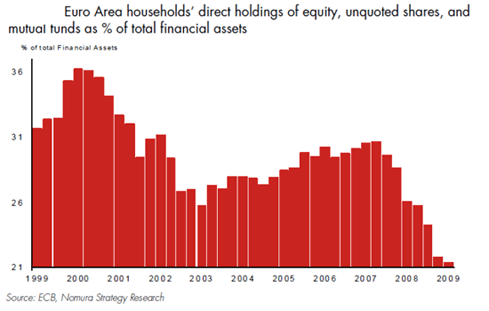
ECB’s latest data on asset allocation of Europe’s insurers
According to the ECB, the largest euro area insurers have been de-risking their balance sheets by reducing their exposure to equities and increasing their exposure to corporate and government bonds. What is worrying about this chart is that it only shows the change from 2007 and 2008. It will look much worse for equities when the 2009 data comes in!
Sovereign Wealth Funds Update 2009
IROs are constantly asking us about interacting with SWFs (Sovereign Wealth Funds) but they also have many reservations, mainly due to the limited disclosure and poor transparency of some entities. In our role as IR consultants we frequently advise IROs on specific SWFs and facilitate access to key decision makers. In this update we’ve pulled together some recent data which we believe is interesting and worth sharing with you. If you would like to know more, please don’t hesitate to contact us directly.
- IFSL estimates that AUM of SWFs increased by 18% in 2008 to $3.9 trillion. Huge losses on some investments were more than offset by inflows. IFSL projections are that SWFs are likely to double from their current level to around $8 trillion in 2015.

- SWFs are already significantly bigger than hedge funds.

- Around 45% of SWFs come from oil rich countries in the Middle East.

- Pensions & Investments magazine estimates approx 45% of SWF assets are managed by external managers. This may decline as more SWFs develop internal capabilities and shift from passive to active strategies.
- Deutsche Bank estimates changing asset allocation could lead to an inflow of more than $1 trillion into global equity markets and $1.5 trillion into debt markets between 2008 and 2013.
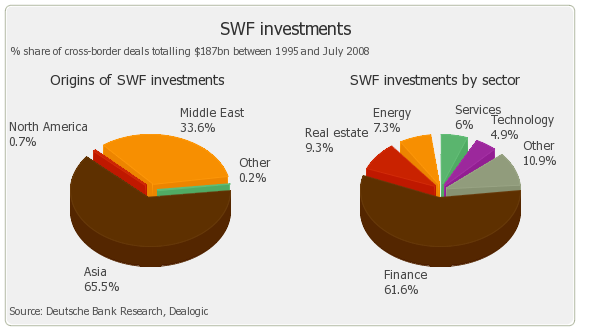
- Around 80% of oil exporting SWFs are invested in overseas assets with 50% of these investments in equities, 25% in fixed income and 15% in cash. The US is the destination for more than half of these investments with around 20% destined for Europe. More recently some SWFs have been emphasizing investments in their domestic markets and Asia.
NIRI Conference – Changing role of the sell-side
I’ve just come out of a session about the changing role of the sell-side and must say how surprised I was to hear so much bashing of the sell-side. Clearly their business model is under a lot of pressure given the current environment but the sentiment in this very well attended session (standing room only) seemed to be against using the sell-side to facilitate corporate access because they no longer do a good job, don’t deliver the right investors and can’t get good feedback from PMs. One of the speakers from the buy-side said they never tell the sell-side what they think about meetings. One IRO stood up at the end of the session and said he was completely confused by the whole situation. Strangely enough, the session next door on corporate social responsibility was not as well attended as it probably should have been. What does this tell you about the issues most on everyone’s minds?
NIRI Conference – Targeting International Investors
I’ve just finished my session on international outreach. It was well attended and there were some good questions which showed people have a good grasp of targeting Europe. I was lucky enough to have two great co-speakers in Bina Thompson of Colgate-Palmolive and Jeff Smith of FedEx, both of whom have a lot of experience in Europe. If you missed the session and are interested in the presentation, you can access a copy of the slides as well as an audio recording by clicking on this link: http://www.niristream.org/c/b.cgi?s=MKT2

